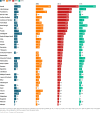Morbidity transition at the national and sub-national level and their determinants over the past and contemporary period in India
- PMID: 38905255
- PMCID: PMC11192379
- DOI: 10.1371/journal.pone.0304492
Morbidity transition at the national and sub-national level and their determinants over the past and contemporary period in India
Abstract
The study delves into the epidemiological transition, examining the intricate changes in health status patterns and their connection to morbidities. Specifically, it assesses morbidity transition at both national and subnational levels in India and their determinants from 1995 to 2018. This study examines self-reported morbidities in India by utilising four rounds of National Sample Survey Organisation (NSSO) data (52nd, 60th, 71st, and 75th) from 1995-2018. We estimated prevalence by conducting descriptive analysis on socio-demographic determinants and morbidities such as: Infectious and Communicable Diseases (In&CDs), Non-communicable diseases (NCDs), Disability and other diseases. Moreover, we employed pooled regression analysis to explore morbidity risk transitions over the past decades. The study revealed a steady upsurge in morbidity prevalence in India, doubling from 56 (per thousand) in 1995 to 106 in 2014. However, a considerable decline was observed in the most recent round in 2018 (79 per thousand). From 1995 to 2018, NCDs gained a prominent share in morbidity trends. Kerala in the southern region reported the highest rates, followed by states like Lakshadweep, Andhra Pradesh, Karnataka, West Bengal, Punjab, and others. Age, sex, residence, education, caste, religion, and wealth are pivotal factors in determining the severity of different disease burdens in different sections of the population in India. Over the study period (1995, 2004, 2014, and 2018), the odds of reported morbidities risk transition significantly increased over successive decades: 1.81 times in 2004 (95% CI: 1.78-1.84), 2.16 times in 2014 (95% CI: 2.12-2.2), and 1.44 times in 2018 (95% CI: 1.41-1.46), compared to 1995 (52nd round). The study reveals significant disparities in morbidity reporting across Indian states from 1995 to 2018, attributed to distinct demographic, social, and economic determinants. India continues to grapple with the dual burden of diseases, but the NCDs burden is mounting at a faster pace than CDs.
Copyright: © 2024 Bramhankar, Dhar. This is an open access article distributed under the terms of the Creative Commons Attribution License, which permits unrestricted use, distribution, and reproduction in any medium, provided the original author and source are credited.
Conflict of interest statement
The authors have declared that no competing interests exist.
Figures
Similar articles
-
Emerging trends and patterns of self-reported morbidity in India: Evidence from three rounds of national sample survey.J Health Popul Nutr. 2017 Aug 9;36(1):32. doi: 10.1186/s41043-017-0109-x. J Health Popul Nutr. 2017. PMID: 28793930 Free PMC article.
-
Burden of communicable and non-communicable diseases-related inequalities among older adults in India: a study based on LASI survey.BMC Geriatr. 2022 Oct 10;22(1):790. doi: 10.1186/s12877-022-03481-x. BMC Geriatr. 2022. PMID: 36217103 Free PMC article.
-
SELF-REPORTED MORBIDITY AND BURDEN OF DISEASE IN UTTAR PRADESH, INDIA: EVIDENCE FROM A NATIONAL SAMPLE SURVEY AND THE MILLION DEATHS STUDY.J Biosoc Sci. 2016 Aug;48(4):472-85. doi: 10.1017/S0021932015000322. Epub 2015 Oct 5. J Biosoc Sci. 2016. PMID: 26434255
-
Disease and age pattern of hospitalisation and associated costs in India: 1995-2014.BMJ Open. 2018 Jan 24;8(1):e016990. doi: 10.1136/bmjopen-2017-016990. BMJ Open. 2018. PMID: 29371266 Free PMC article.
-
Health inequalities research in India: a review of trends and themes in the literature since the 1990s.Int J Equity Health. 2016 Oct 6;15(1):166. doi: 10.1186/s12939-016-0457-y. Int J Equity Health. 2016. PMID: 27716296 Free PMC article. Review.
References
-
- Omran A. La transición epidemiológica: una teoría de la epidemiología del cambio poblacional. 1971. Milbank Mem Fund Q. 1971;49(1):509–38. - PubMed
-
- Worldometer. Worldometer. 2023 [cited 2023 Jun 9]. Population by Country (2023) ‐ Worldometer. Available from: https://www.worldometers.info/world-population/population-by-country/.
-
- WPR WPR. World Population Review. 2023 [cited 2023 Oct 9]. India States 2023. Available from: https://worldpopulationreview.com/country-rankings/india-states.
-
- Bose M. Social and Cultural History of Ancient India. Concept Publishing Company; 1998. 200 p.
-
- Visaria L. The continuing fertility transition. In 2004. p. 57–73.
MeSH terms
Grants and funding
LinkOut - more resources
Full Text Sources
Miscellaneous



